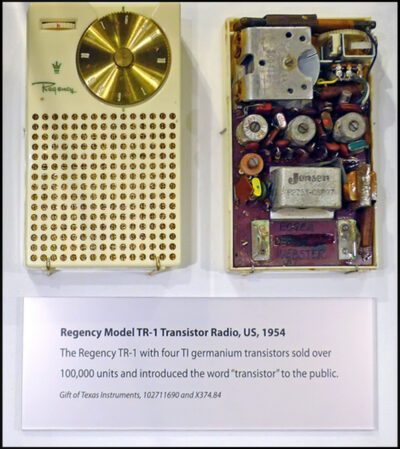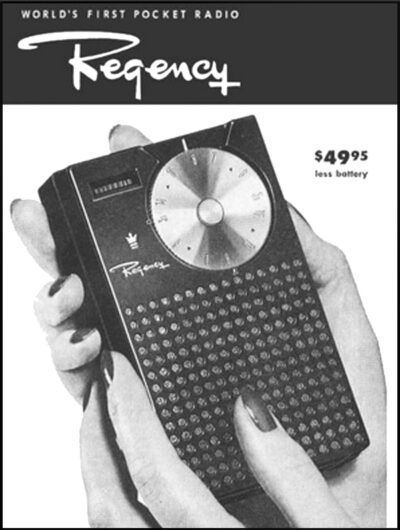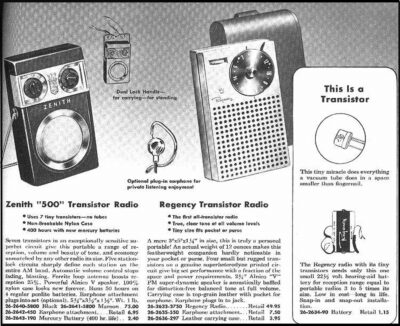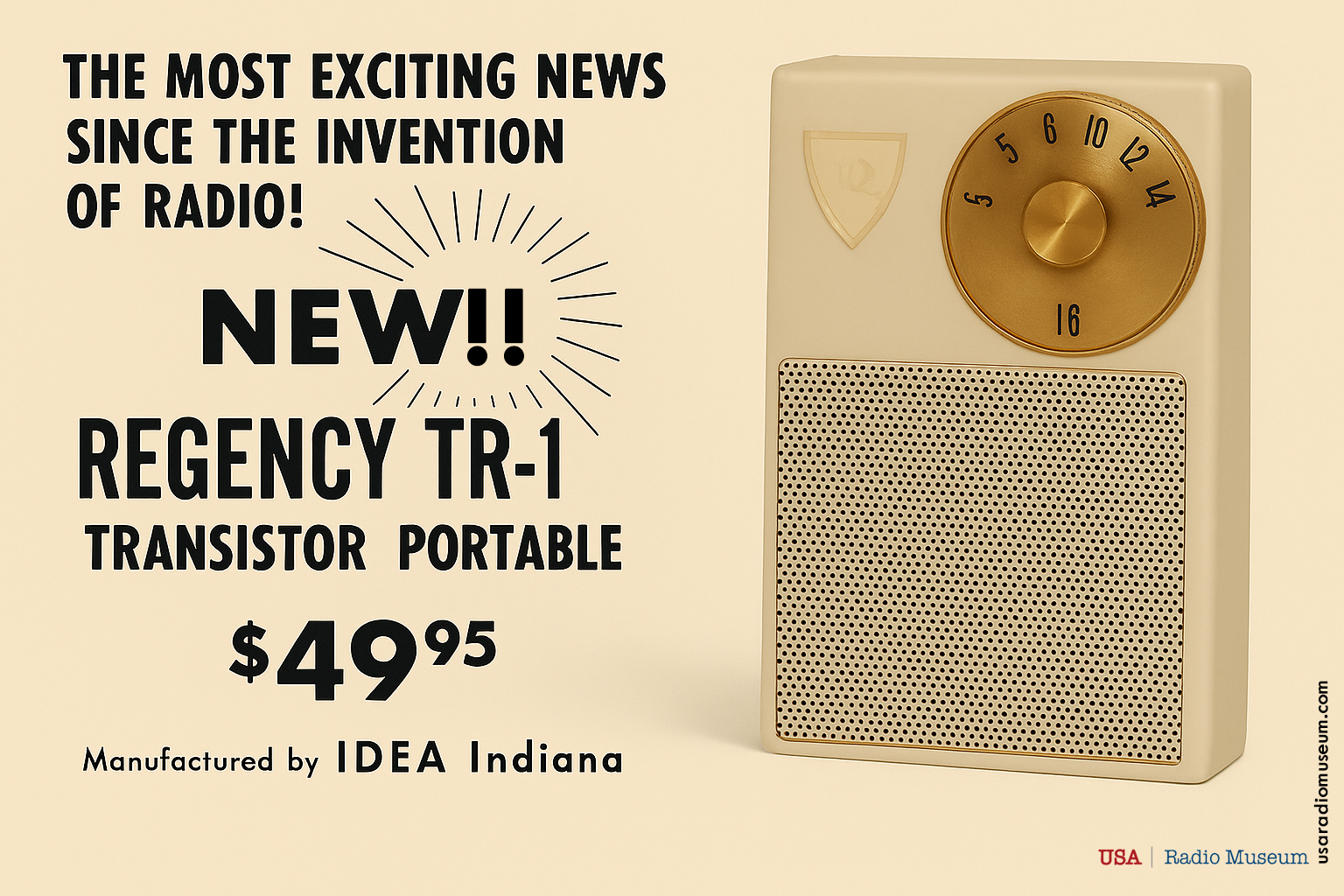Waves of Change: The Regency TR-1 and the Transistor Radio Revolution In the autumn of 1954, in a country enchanted by chrome tail fins, drive-
Waves of Change: The Regency TR-1 and the Transistor Radio Revolution
 In the autumn of 1954, in a country enchanted by chrome tail fins, drive-ins, and bobby socks, something far smaller than a Cadillac began rewriting the rules of American culture. It didn’t roar. It barely hummed. But when the tiny red box in your hand lit up the AM dial without tubes or cords, you weren’t just hearing a signal—you were holding a signal of what was to come.
In the autumn of 1954, in a country enchanted by chrome tail fins, drive-ins, and bobby socks, something far smaller than a Cadillac began rewriting the rules of American culture. It didn’t roar. It barely hummed. But when the tiny red box in your hand lit up the AM dial without tubes or cords, you weren’t just hearing a signal—you were holding a signal of what was to come.
Meet the Regency TR-1: the first commercially available transistor radio, the harbinger of pocket media, and one of the great unsung pivots in technology history.
Born of Silicon and Grit
The transistor itself was still new—born in 1947 at Bell Labs but largely confined to government and industrial use through the early 1950s. Texas Instruments, a young company in Dallas, believed transistors could leap from classified blueprints to living rooms. What they needed was a consumer product to prove it.
But when TI pitched the idea of a portable transistor radio to major electronics companies like RCA and Emerson, they were shown the door. Vacuum tubes, those companies insisted, were still the gold standard.
Enter Industrial Development Engineering Associates (I.D.E.A.), a small Indianapolis firm known for television signal boosters. Texas Instruments proposed a partnership: TI would supply its experimental transistors; I.D.E.A. would design, build, and market the device.
It was a bold bet, one that would pay off in more than just dollar signs.
The First of Its Kind
The Regency TR-1 hit select stores on November 1, 1954. About the size of a postcard and tipping the scale at just 12 ounces, the TR-1 fit in the palm of your hand. No warm-up time. No glowing tubes. Just four Texas Instruments germanium transistors and a 22.5-volt battery humming inside a glossy plastic shell.
It was, technologically, a marvel. Those four transistors—one as a frequency converter, two for intermediate amplification, and one for audio—formed a super heterodyne receiver circuit. A diode served as the detector. The audio fidelity was modest and reception sometimes spotty, but that wasn’t the point.
The point was freedom. For the first time in history, radio moved with you.
Design for the Jet Age
The TR-1 didn’t just sound different. It looked like it had crash-landed from the future.
Industrial design firm Painter, Teague and Petertil crafted a device that exuded mid-century elegance. The speaker grille was circular and minimalist, flanked by a tuning dial with distinctive “TR-1” engraving. Early models launched in bold colors: mandarin red, cloud gray, ivory, and black. Later came hues like lavender, turquoise, and even pearlescent pink.
The TR-1 wasn’t just sold—it was styled. In an era when cars had fins and dishwashers came in pastels, the TR-1 spoke fluent 1950s: compact, personalized, and cool.
Marketing the Impossible
 At $49.95, the TR-1 wasn’t cheap—it cost more than a week’s wages for many Americans. Adjusted for inflation, that’s over $500 in today’s dollars. But its arrival was timed perfectly.
At $49.95, the TR-1 wasn’t cheap—it cost more than a week’s wages for many Americans. Adjusted for inflation, that’s over $500 in today’s dollars. But its arrival was timed perfectly.
TV might have ruled the living room, but radio was going mobile. Regency’s ads promised listeners they could tune in anywhere: the beach, the commute, the picnic table, or even the fallout shelter.
Slick department store placements in New York and Los Angeles paired with glowing profiles in technology magazines. The buzz was instant. Tech-savvy teens, electronics hobbyists, and curious commuters couldn’t resist the call.
By Christmas 1954, the first production run had sold out.
The Psychology of Portability
The TR-1’s most radical achievement wasn’t technical. It was psychological.
Radios had always been shared: families gathered around large consoles for Roosevelt’s Fireside Chats or The Lone Ranger. But now—finally—radio was personal. Teenagers could sneak rock ’n’ roll under the covers. Travelers could monitor the weather on the bus. Lovers could retreat to a quiet place and let the static fill the silence.
The TR-1 introduced an entirely new concept: media you could take with you. It was the iPod, the smartphone, the Spotify playlist of its time—a silent revolution in how we related to sound and space.
Voices from the Airwaves: What They Said About the TR-1
From the Advertisements
Regency’s original marketing didn’t hold back. One 1954 ad declared:
“The most exciting news in radio since the invention of radio!”
Another boasted:
“No tubes. No cords. No limits.”
And in a nod to Cold War anxieties, one campaign suggested the TR-1 was perfect for:
“Your bomb shelter emergency kit—because even in silence, you deserve a signal.”
From Industry Observers
A retrospective from CollectorNet captures the design’s enduring appeal:
“There’s an allure to the Regency TR-1 transistor radio that can’t be denied. It was the first widely sold transistorized consumer product, had beautiful and daring styling for the time (styling that still holds up, in my opinion), and further demonstrated the significance of engineering and technology in the 20th century.”
From Historians and Collectors
Paul R. Farmer, writing for the Antique Wireless Association, called the TR-1:
“A technological and cultural watershed… the paradigm shift from vacuum tube to semiconductor technology had begun in earnest.”
From the Public
While direct consumer reviews from 1954 are rare, the buzz was unmistakable. One department store reportedly sold out of its entire TR-1 stock within hours of launch. And in a 1955 San Bernardino County Sun ad, a testimonial read:
“I never thought I’d carry the news in my coat pocket. Now I do.”
Made in the U.S.A.
What surprises many today is this: the TR-1 was entirely American-made. From the transistors forged in Texas to the plastic housing molded in Indiana, this revolutionary gadget was homegrown.
That wouldn’t remain true for long. The TR-1’s impact was so profound that it immediately caught the attention of a rising force in global electronics: Japan.
Transistor Trailblazers: Zenith and Philco Step Up
 The TR-1’s success inspired major U.S. players to rethink their approach.
The TR-1’s success inspired major U.S. players to rethink their approach.
First up was Zenith Electronics, a household name in radio. Their reply came in 1956 with the Zenith Royal 500, often dubbed the “Owl’s Eyes” radio for its twin-dial design. It used seven transistors and offered greater sound clarity and range. The Royal 500 was rugged, handsome, and American to its core—assembled by hand and often passed down as heirlooms.
Philco, meanwhile, charted a different course. In 1955, they partnered with Chrysler to roll out the world’s first transistorized car radio—the Mopar 914HR. Suddenly, the idea of portable radio expanded to the dashboard. After Ford’s acquisition of Philco in 1961, the brand continued producing stylish, compact portables, such as the six-transistor T-612BK, often adorned with the Philco-Ford nameplate.
Together, these companies formed the first wave of the transistor renaissance in American manufacturing, made possible because one little radio had shown it could work.
Global Ripple Effect: Japan Enters the Chat
In Tokyo, a fledgling company called Tokyo Tsushin Kogyo watched the TR-1 closely. They released their own transistor radio—the Sony TR-55—in 1955. But it was their TR-63, launched in 1957, that changed the game.
The Sony TR-63 was smaller than the TR-1, lighter, and more reliable. Crucially, it was built for export, and it became the first Japanese consumer electronics product to conquer the U.S. market. Over 100,000 units were shipped to American shores in its first year.
The TR-63’s stunning success not only helped establish Sony as a global brand, but it also helped redefine the perception of Japanese products from “cheap knockoffs” to sleek, affordable, and technologically superior alternatives.
By 1959, Japanese companies were flooding the world market with transistor radios—portable, affordable, and ubiquitous.
But they all stood on the shoulders of one—Regency’s TR-1.
Legacy of a Lightning Bolt
 Today, the Regency TR-1 is a prized collector’s item, with working models fetching thousands on auction sites. Museums including the Smithsonian Institution, the Museum of Broadcast Communications, and design showcases across Europe proudly display its compact frame as a symbol of human ingenuity and artistic elegance.
Today, the Regency TR-1 is a prized collector’s item, with working models fetching thousands on auction sites. Museums including the Smithsonian Institution, the Museum of Broadcast Communications, and design showcases across Europe proudly display its compact frame as a symbol of human ingenuity and artistic elegance.
And its legacy? It’s in every podcast streamed on your phone. Every playlist scrolled through at the gym. Every Bluetooth speaker at the beach. That little spark—four transistors, a single diode, and a bold idea—lit the fuse of personalized media.
The Final Frequency
The Regency TR-1 wasn’t built to dominate the market. It wasn’t the best-sounding, nor the cheapest, nor the most mass-produced. But sometimes, being first is the greatest innovation of all.
With its crackling speaker, its candy-colored shell, and its daring debut, the TR-1 did more than tune into AM—it tuned in to a new human experience.
So the next time you carry your music in your pocket or bring news along for the ride, remember this: it started in Indianapolis, in 1954, with four transistors, no tubes, and a whole lot of imagination combined inside a little plastic box.
And oh, what a sound that made.
_____________________
A USARM Viewing Tip: On your mobile or tablet device? Finger-tap all the above images inside the post and stretch image across your device’s screen for LARGEST digitized view.

